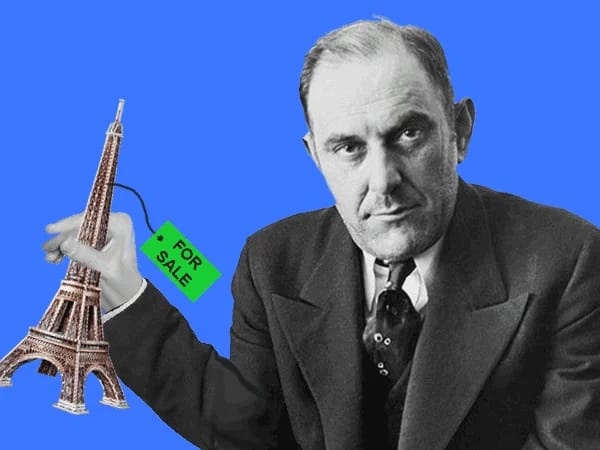- Thunderbolt AI
- Posts
- 🗼 The Con Man Who Sold the Eiffel Tower — Twice!
🗼 The Con Man Who Sold the Eiffel Tower — Twice!
Plus, 💼 Cisco Launches $1 Billion AI Investment Fund

🌟 Welcome to the Latest Edition of Thunderbolt AI! 🌟
Hey there, AI enthusiasts! We're back with another electrifying edition of Thunderbolt AI. Get ready to dive into some exciting reads that will keep you at the edge of your seat! ⚡️
🔎 What's in Store for You Today:
🗼 Sold the Eiffel Tower Twice!
💼 Cisco's $1B AI Fund
🧠 Brainstorm with ChatGPT
Don’t forget! If you are here thanks to a friend, subscribe here to ensure you never miss out on the growth insights!
Stay tuned as we delve into these intriguing articles that are sure to spark your curiosity and keep you informed.
Let's get started!
MARKETING
🗼 The Con Man Who Sold the Eiffel Tower — Twice!
Source: The Hustle

Overview:
Victor Lustig, a notorious con man, managed to sell the Eiffel Tower not once, but twice! This audacious scam is a testament to his cunning and charm, making him one of history’s most legendary swindlers.
1. International Man of Mystery 🌍: Victor Lustig, whose real name was Robert Miller, was born in 1890 in Hostinné, Austria-Hungary. He quickly showed a knack for deception, adopting aristocratic aliases and moving through Europe with ease, scamming people at every turn.
2. Master of Deception 🎩: Lustig’s scams ranged from bait-and-switch schemes to selling fake historical documents. He even scammed transatlantic ship passengers by rigging poker games. His ability to charm and deceive made him a master con artist.
3. The Eiffel Tower Scam🗼: By 1925, the Eiffel Tower was an unpopular eyesore among Parisians, giving Lustig the perfect opportunity for his most audacious scam. He posed as a government official and convinced businessman André Poisson to buy the Eiffel Tower for scrap metal.
4. The Setup 📝: Lustig took a room at the upscale Hotel de Crillon and transformed a basement storage room into an office. Using official letterhead obtained by an accomplice, he invited prominent businessmen to secret meetings, presenting himself as the deputy director general of the ministère de postes et télégraphes.
5. The Pitch🎯: Lustig spun a convincing tale about the government’s secret plan to sell the Eiffel Tower. He emphasized the need for discretion due to the controversial nature of the sale. Poisson, eager to make his mark, fell for the scam and paid 1.2 million francs for the tower, plus an additional 70,000 francs in bribes.
6. The Escape 🏃♂️: After the first successful scam, Lustig fled to Vienna before Poisson realized he had been conned. Embarrassed, Poisson did not report the scam to the police. Lustig, emboldened by his success, attempted to sell the tower again. This time, however, his second victim suspected the scam and alerted the authorities, forcing Lustig to flee Paris permanently.
7. A Charming Rogue 🤵: Lustig’s accomplices remembered him as a charming rogue. He manipulated his victims with ease, playing on their greed and ambition. Despite the eventual exposure of his scams, Lustig’s ability to deceive and charm left a lasting impression.
8. Final Moves in Chicago 🏠: Lustig moved his wife and daughter to the Chicago suburbs, continuing his life of crime in America. His career is a fascinating study in the art of deception and the lengths to which a skilled con artist can go.
Conclusion: "The Art of the Con" 🎭
Victor Lustig’s story of selling the Eiffel Tower twice showcases the incredible power of charm, deception, and audacity. His scams were not just about the money; they were about crafting a believable fantasy and convincing others to buy into it. Lustig remains a legend in the world of con artists, a testament to the enduring allure of the well-executed scam. Catch you next week for more thrilling tales! 🗼💼
TOGETHER WITH 1440:
All your news. None of the bias.
Be the smartest person in the room by reading 1440! Dive into 1440, where 3.5 million readers find their daily, fact-based news fix. We navigate through 100+ sources to deliver a comprehensive roundup from every corner of the internet – politics, global events, business, and culture, all in a quick, 5-minute newsletter. It's completely free and devoid of bias or political influence, ensuring you get the facts straight.
D-AI-LY DIGEST
💼 Cisco Launches $1 Billion AI Investment Fund.

Overview:
Cisco Investments launches a $1 billion AI fund to support startups and advance generative AI and large language models (LLMs).
Key Details:
Investment Recipients: Cisco backs Cohere, Mistral AI, and Scale AI, each valued in the billions.
Market Projections: The generative AI market is projected to reach $137 billion by 2030, potentially adding $1 trillion to the U.S. economy over the next decade.
Strategic Moves:
Supporting Innovation: Cisco's investments aim to bridge the gap between lab innovations and enterprise applications.
Notable Investments:
Mistral AI: Focuses on new gen AI models for enterprises, including the Mistral 7B and Codestral, a code-generating LLM.
Cohere: Known for security-focused LLMs and retrieval-augmented generation (RAG) capabilities, backed by a $450 million round with Nvidia, Salesforce Ventures, and PSP Investments.
Scale AI: Provides training and validation for AI applications, with a valuation of $13.8 billion following a $1 billion Series F round.
Investment Philosophy:
Customer Needs: Investments address evolving customer needs.
Technical Challenges: Focus on companies solving complex technical issues for groundbreaking advancements.
Long-Term Partnerships: Emphasis on team fit and cultural alignment, with active engagement and support for portfolio companies.
Significance:
Cisco’s substantial investment underscores its commitment to AI innovation and its strategic role in advancing generative AI and LLM technologies, positioning itself at the forefront of the AI-driven future.
LEARNING AI
How to Brainstorm and Create a Mind Map with ChatGPT
Log In: Go to ChatGPT and log into your account.
Select Model: Ensure you select GPT-4 at the top.
Ask for Help: Ask ChatGPT to help you brainstorm by providing the main topic and sub-topics.
Create Mind Map: Use the prompt: “Create a mind map to brainstorm new ideas for our [enter details]. Start with the central topic of [enter the main topic] and branch out to subtopics such as [enter sub-topics].”
Generate Image: Turn the interactive chart into a static image by selecting the click icon at the top.
Conclusion: Using ChatGPT to brainstorm and create mind maps makes organizing ideas simple and effective, transforming your thoughts into a visual masterpiece. 🧠💡
AI TOOLS:
🔨Make your day easier. The ultimate AI tools you cannot miss.
🎨 Genmo AI: Employ Genmo AI, a GPT4-powered creative chatbot that accepts image inputs to generate and edit images and videos, providing creative solutions at your fingertips.
🛠️ Adobe Sensei: Elevate your design work in Photoshop, Illustrator, and InDesign with Adobe Sensei, a transformative AI tool that enhances your creative projects.
🚀 Bunch: Enhance your leadership skills in just 2 minutes a day with Bunch, an AI coaching app trusted by managers at top companies like Google and Amazon.
Also as we prepare more “Lightning-Marketing Case Study” content for tomorrow, we’d love to hear your thoughts on today’s edition! Feel free to share this with someone who would appreciate it

